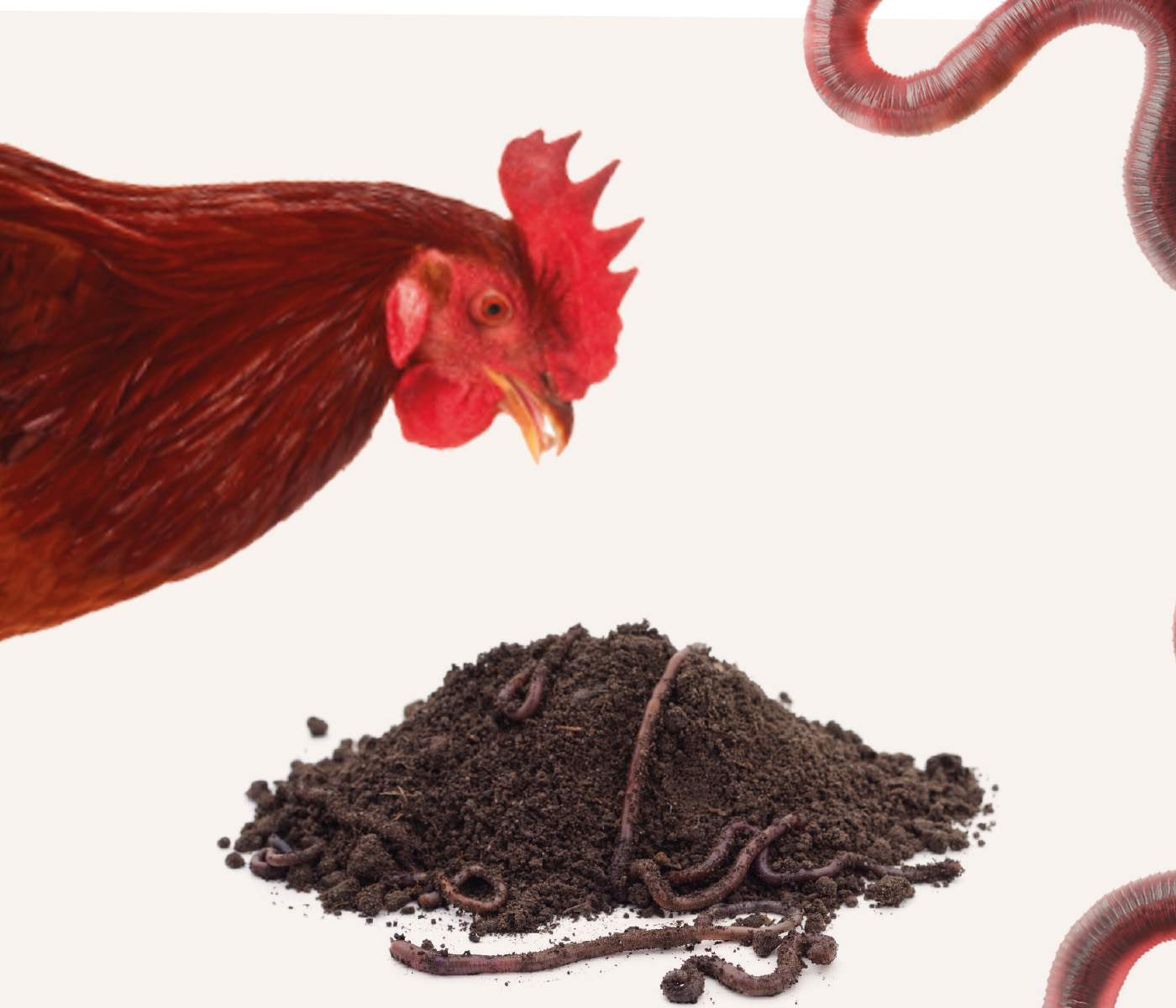 16 Oct 2023
16 Oct 2023
Worm meal as an alternative to soybean meal in the laying hen diets.
In a general context, poultry nutrition in Brazil predominantly relies on corn and soybean meal as primary constituents. These two elements can make up as much as 90% of the overall diet, and thus, they constitute a substantial share of the expenses associated with animal feed, ultimately impacting the total production costs. Not only are these ingredients prone to price fluctuations, exhibiting instability in recent years, but they also directly vie with human food resources, as more than 60% of the nation’s total production of these commodities is channeled into the animal feed industry.
| Currently, there is extensive research into the utilization of insect proteins, like those derived from Eisenia fetida, particularly in poultry farming. These studies have highlighted the potential of worm meal as a viable alternative protein source in the formulation of animal feed. |
Numerous attributes of worm meal render it a suitable foundational ingredient for formulation. Worms’ protein content fluctuates based on their diet, spanning from 68% to 82% in terms of crude protein. 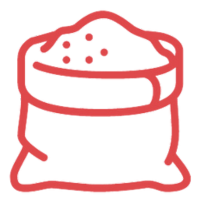 Worm meal is renowned for its top-tier protein, boasting an exceptional array of essential amino acids and fatty acids. Consequently, it can be deemed exceptionally well-suited for animal nutrition. It’s worth noting that the existing literature on this subject has not reported any instances of quality interference with the end product, and there are no studies available that have explored the integration of worm meal into the diets of laying hens. minhoca na alimentação de poedeiras. [register]
Worm meal is renowned for its top-tier protein, boasting an exceptional array of essential amino acids and fatty acids. Consequently, it can be deemed exceptionally well-suited for animal nutrition. It’s worth noting that the existing literature on this subject has not reported any instances of quality interference with the end product, and there are no studies available that have explored the integration of worm meal into the diets of laying hens. minhoca na alimentação de poedeiras. [register] 

 The nutritional composition of the feed given to laying hens has a direct impact on the quality of the eggs they produce. Chicken eggs are a highly nutritious and economically accessible food source, available in both fresh and processed forms, and widely employed across the food industry. Their affordability and nutritional value, when compared to other animal-derived proteins, position them as a nutritious and cost-effective food choice, playing a pivotal role in addressing issues related to hunger and malnutrition.
The nutritional composition of the feed given to laying hens has a direct impact on the quality of the eggs they produce. Chicken eggs are a highly nutritious and economically accessible food source, available in both fresh and processed forms, and widely employed across the food industry. Their affordability and nutritional value, when compared to other animal-derived proteins, position them as a nutritious and cost-effective food choice, playing a pivotal role in addressing issues related to hunger and malnutrition. 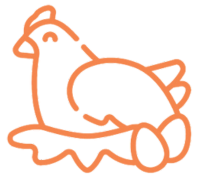
The study was carried out over a 69-day period, which was divided into three phases of 23 days each. Thirty-six birds of commercial lineage, all at 50 weeks of age, were employed.Before the study commenced, the animals underwent a 10-day adaptation period. Subsequently, they were divided into groups of 12 birds per treatment. Feed and water were available ad libitum.
 To make these measurements, the Eggtester® equipment was utilized in the egg analysis laboratory at the Faculty of Animal Science and Food Engineering (FZEA/USP) located at the Fernando Costa Campus in Pirassununga, USP. Yolk and albumen weights were measured separately using a standard scale, while digital calipers (Mitutoyo®) were employed for determining shell thickness, with an average taken from three equatorial points per egg. The experimental design followed a completely randomized (CRD) approach, with two repetitions for each of the three levels of worm meal in the feed (0%, 2%, and 4%) as partial replacements for soybean meal as a protein source.
To make these measurements, the Eggtester® equipment was utilized in the egg analysis laboratory at the Faculty of Animal Science and Food Engineering (FZEA/USP) located at the Fernando Costa Campus in Pirassununga, USP. Yolk and albumen weights were measured separately using a standard scale, while digital calipers (Mitutoyo®) were employed for determining shell thickness, with an average taken from three equatorial points per egg. The experimental design followed a completely randomized (CRD) approach, with two repetitions for each of the three levels of worm meal in the feed (0%, 2%, and 4%) as partial replacements for soybean meal as a protein source.
The diets were administered daily, specifically formulated to meet the nutritional requirements of the animals in an isoenergetic and isonutritive manner. These diets contained worm meal in proportions of 0%, 2%, and 4%, corresponding to treatments 1, 2, and 3, respectively.
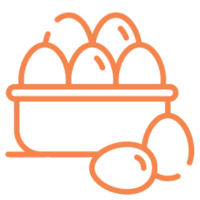 Egg quality data underwent analysis of variance. In cases of significant differences, means were compared using the Tukey test at a significance level of 0.05. Prior to this analysis, normality of residuals was confirmed using the Shapiro-Wilk test, and homogeneity of variances was checked with the Levene test.
Egg quality data underwent analysis of variance. In cases of significant differences, means were compared using the Tukey test at a significance level of 0.05. Prior to this analysis, normality of residuals was confirmed using the Shapiro-Wilk test, and homogeneity of variances was checked with the Levene test.When it comes to average egg weight, it was observed that treatment 3 showed a higher weight in comparison to the others. This outcome is attributed to the higher tryptophan content in the diet with 4% inclusion of worm meal, corroborating findings by Harms and Russel (2000).
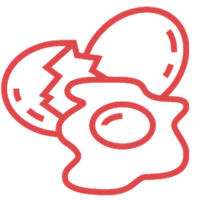 Concerning egg yolk color, treatment 3 also exhibited a more satisfactory result, explained by the increased corn content in the diet and the higher concentration of tryptophan, which influences this quality parameter, as indicated by Santos et al. (2018). In terms of the Haugh unit (HU), the Quality Control Program, following recommendations by the United States Department of Agriculture (USDA), classifies eggs as:
Concerning egg yolk color, treatment 3 also exhibited a more satisfactory result, explained by the increased corn content in the diet and the higher concentration of tryptophan, which influences this quality parameter, as indicated by Santos et al. (2018). In terms of the Haugh unit (HU), the Quality Control Program, following recommendations by the United States Department of Agriculture (USDA), classifies eggs as:
Given this classification, it can be affirmed that despite significant differences between treatments, all levels resulted in eggs with HU values exceeding 88, categorizing them as excellent for consumption.  Analyzing data regarding albumen height and weight across treatments, it can be concluded that the inclusion of worm meal in the diet did not yield significant advantages in these parameters. This is in contrast to yolk weight, which increased in the treatments with worm meal. This increase can be attributed to the enhanced availability of amino acids that phosphorylate with phosvitin, which constitutes the granular portion of the yolk, as explained by Macari et al. (2013).
Analyzing data regarding albumen height and weight across treatments, it can be concluded that the inclusion of worm meal in the diet did not yield significant advantages in these parameters. This is in contrast to yolk weight, which increased in the treatments with worm meal. This increase can be attributed to the enhanced availability of amino acids that phosphorylate with phosvitin, which constitutes the granular portion of the yolk, as explained by Macari et al. (2013).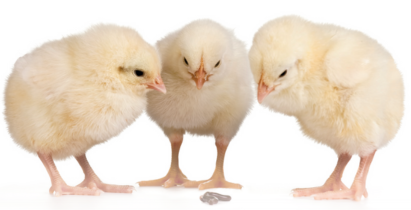
 Regarding external egg quality, the inclusion of worm meal in the diets did not affect shell strength. However, assessment of shell weight and thickness revealed values higher than those obtained with the control diet when worm meal was added. This observation can be attributed to the solubility of calcium (Ca) present in worm meal, which, being of organic origin, boasts higher bioavailability and intestinal absorption, as it has a strong correlation with mineral solubility, as noted by Melo et al. (2006).
Regarding external egg quality, the inclusion of worm meal in the diets did not affect shell strength. However, assessment of shell weight and thickness revealed values higher than those obtained with the control diet when worm meal was added. This observation can be attributed to the solubility of calcium (Ca) present in worm meal, which, being of organic origin, boasts higher bioavailability and intestinal absorption, as it has a strong correlation with mineral solubility, as noted by Melo et al. (2006).
The partial substitution of soybean meal with worm meal resulted in improved indices related to egg weight, yolk color, yolk weight, shell thickness, and shell strength.
Source: This article was originally published as a content in portuguese on nutriNews Brasil
References available upon request. [register/]
Subscribe now to the technical magazine of animal nutrition
AUTHORS

Nutritional Interventions to Improve Fertility in Male Broiler Breeders
Edgar Oviedo
The Use of Organic Acids in Poultry: A Natural Path to Health and Productivity
M. Naeem
Synergistic Benefits of Prebiotics and Probiotics in Poultry, Swine, and Cattle
Gustavo Adolfo Quintana-Ospina
Hybrid Rye Potential in Laying Hen Feed Rations
Gwendolyn Jones
A day in the life of phosphorus in pigs: Part I
Rafael Duran Giménez-Rico
Use of enzymes in diets for ruminants
Braulio de la Calle Campos
Minerals and Hoof Health in the Pregnant Sow
Juan Gabriel Espino
Impact of Oxidized Fats on Swine Reproduction and Offspring
Maria Alejandra Perez Alvarado